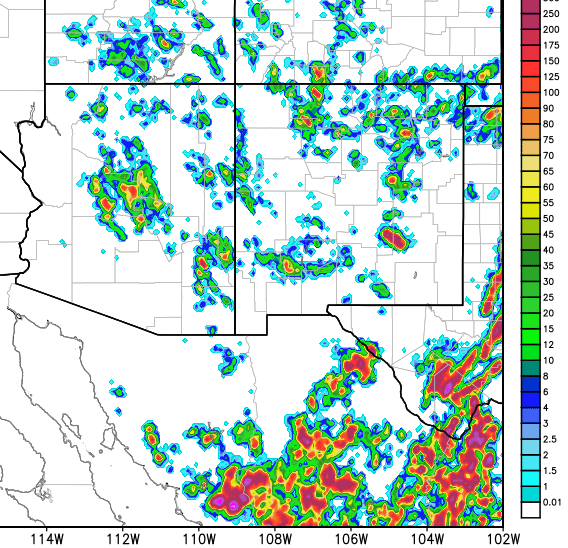Edited to add: The 12 UTC forecasts from the WRF model are considerably different than those at 06 UTC, and they now forecast more storm activity in Pima County. Watch for Mike's discussion.
WRF forecasts for Pima County yesterday were quite good, as only very isolated showers occurred. The above, from Maricopa County FCD, shows gauge adjusted radar rainfall estimates for 24-hours ending at 6:00 am MST this morning. Graphic below shows flash density for detected CGs for 24-hours ending at 7:00 am this morning (from weather.graphics and Vaisala) - with thunderstorms staying mostly over higher terrain to the north. One ALERT site in Oro Valley measured 0.12" and that was only gauge with rainfall.
This morning's skewT plot (from SPC) of the upper-air data from TWC is little changed from yesterday. Easterlies are deeper and upper tropospheric winds are lighter. At 500 mb the trough/shear zone between the anticyclonic centers (now over northeastern Utah and southeastern Oklahoma) has inched westward a bit, while an upper-tropospheric vorticity maximum pulls northeastward from northern Mexico heading toward New Mexico.
The 06 UTC forecasts from the WRF-NAM (and also the GFS version) indicate little shower or storm activity today for southeastern Arizona, except along the border with New Mexico. Although, the models forecast PW to increase during the day, this is countered in the forecasts by middle-level warming - above WRF-NAM forecast of 500 mb wind and temperature is valid at 2:00 pm, with forecast temperatures around -5C or warmer. The forecast skewT for TWC valid at 2:00 pm (below) has 33 mm of PW but almost no CAPE.
The most active weather remains down in the tropics. Hurricane Lester is a Cat 4 storm this morning, while weakening Hurricane Madeline will brush the Big Island later today and tonight. The NHC expects TD Nine (currently over the GoM) to strengthen into a TS today (Hermine) and make landfall tomorrow night over northern Florida, with winds of around 50 mph. However, in a CYA mode the NHC has also issued a hurricane watch for northern Florida.




















































